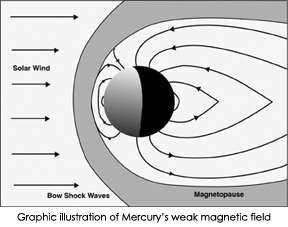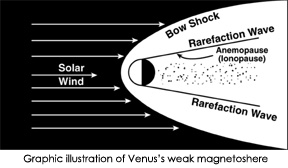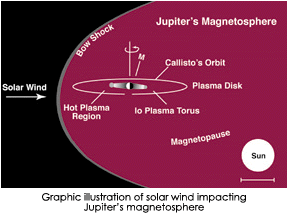|
Do other solar system planets have protective
magnetospheres?
In the past, Mars and Venus may have lost former oceans and
Mars may have lost much of its atmosphere to space as a direct
result of solar wind. Mercury and Venus are between the sun
and the Earth, where the solar wind is more dense and has
a greater magnetic field strength when it passes these planets
than when it impacts the Earth's magnetosphere. Do they
have magnetospheres, and, if so, are they strong enough to
protect them from a Solar Max?
 Mercury
has a magnetic field whose strength is about 1% that of the
Earth's, but it is strong enough that a bow shock forms where
the field interacts with the solar wind. Even though Mercury
lacks an appreciable atmosphere and ionosphere, its magnetic
field is apparently too weak to maintain a belt of charged
particles but strong enough to trap some atoms from the solar
wind. Mercury
has a magnetic field whose strength is about 1% that of the
Earth's, but it is strong enough that a bow shock forms where
the field interacts with the solar wind. Even though Mercury
lacks an appreciable atmosphere and ionosphere, its magnetic
field is apparently too weak to maintain a belt of charged
particles but strong enough to trap some atoms from the solar
wind.
Venus' very weak magnetosphere is no more than 0.09%
the strength of the Earth's and no radiation belts surround
the planet. There is a well-developed bow shock in Venus'
 outer
atmosphere, but there is no evidence of charged particles
being trapped. The solar wind approaches Venus much more closely
than it does the Earth. When the solar wind encounters a nonmagnetic
planet with an atmosphere, the planet's ionosphere creates
forces that slow and divert the flow. Venus' dense atmosphere
and the large-scale currents induced in its conducting ionosphere
prevent the solar wind from reaching its surface. outer
atmosphere, but there is no evidence of charged particles
being trapped. The solar wind approaches Venus much more closely
than it does the Earth. When the solar wind encounters a nonmagnetic
planet with an atmosphere, the planet's ionosphere creates
forces that slow and divert the flow. Venus' dense atmosphere
and the large-scale currents induced in its conducting ionosphere
prevent the solar wind from reaching its surface.
The remaining planets are farther from the sun than the Earth.
Mars is located at 1.5 AU, Jupiter at 5.2 Au, Saturn at 9.5
AU, Uranus at 19 AU, Neptune at 30 AU, and Pluto at almost
40 AU. The solar wind's density and speed decrease with distance
from the sun, so these planets would not need magnetospheres
as strong as the Earth's to protect them.
The global magnetic field of Mars is too weak (about
0.2% that of the Earth's) and the atmosphere too thin to protect
the planet's surface from solar flares. In such a weak magnetic
field, no radiation belts have formed. The solar wind apparently
interacts with the planet's conducting ionosphere, creating
a weak bow shock. There is some indication that the solar
wind may remove as much as 30,000 tons of atmospheric gases
from Mars each year.
Jupiter's magnetosphere is about 100 times  larger
and 20,000 times greater than that of the Earth's. Extremely
high-energy electrons have been found in an enormous disk-shaped
region of its radiation belts. The density of Jupiter's charged
particles is several orders of magnitude greater than that
of Earth's., However, Jupiter's solar wind pressure is only
4% that of Earth's since it is 5.2 AUs from the sun. larger
and 20,000 times greater than that of the Earth's. Extremely
high-energy electrons have been found in an enormous disk-shaped
region of its radiation belts. The density of Jupiter's charged
particles is several orders of magnitude greater than that
of Earth's., However, Jupiter's solar wind pressure is only
4% that of Earth's since it is 5.2 AUs from the sun.
Saturn's magnetosphere is populated with charged particles
making it 500 to 1000 times stronger than the Earth's. Because
of this intense magnetosphere and the low solar wind pressures
at 9.5 AUs from the sun, the bow shock is found 1.44 million
km from the center of Saturn on its sun-ward side. Data from
Voyager 1 indicates that Titan, Saturn's largest satellite,
is the source of substantial quantities of nitrogen ion plasma
for Saturn's inner magnetosphere. Other sources may be the
planet's inner satellites, the planet's rings and its hydrogen-dominated
upper atmosphere. The intensity of all trapped particles decreases
dramatically at the outer edge of ring A.
There have been aurora-like emissions in Uranus' upper
atmosphere, leading us to think that this planet has a magnetosphere.
Voyage 2 found that Uranus has a magnetic field that is about
0.1 that of Saturn and that it is larger than the sun. It
appears to be comprised of plasma ad a large population of
energetic particles. Uranus' upper ionosphere seems to be
the primary source of energized particles, but helium and
heavier nuclei that characterize the solar wind are conspicuously
absent.
Pioneer 10 established that the solar wind extends beyond
Neptune. Voyager 2 found that Neptune's magnetic field
is tilted from the planet's rotational axis and is offset
from the center of the planet. This causes marked changes
in the magnetic field as the planet rotates in the solar wind.
Its field strength varies from 0.1 gauss in the northern hemisphere
to more than 1.0 gauss in the southern hemisphere. Voyager
2 also detected auroras similar to those on Earth, but Neptune's
registered 50 million watts, compared to Earth's 100 billion
watts and occurred over wide regions of the planet's surface.
|
